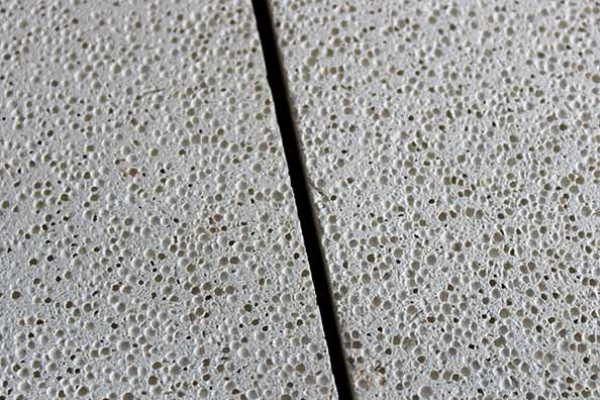
Corundum - mullite at the same time with corundum and mullite two excellent performances.
السيراميك المسامي هو نوع من المواد الخزفية التي تتكون من مسام عديدة مرتبة في الفضاء بطرق مختلفة.
يمكن تقسيم السيراميك المسامي وفقًا لحجم المسام إلى سيراميك مسامي ذو فتحة خشنة (قطر المسام > 500ميكرومتر) فتحة كبيرة مسامية (500ميكرومتر > قطر المسام > 100ميكرومتر), السيراميك المسامي في الفتحة (100ميكرومتر > قطر المسام > 10ميكرومتر), السيراميك المسامي في الفتحة الصغيرة (10ميكرومتر > قطر المسام > 1ميكرومتر), السيراميك المسامي (قطر المسام < 1ميكرومتر).
يمكن تقسيم بنية المسام الموجودة في السيراميك إلى نوع سيراميك مسامي مفتوح المسام, السيراميك ذو المسام المغلقة, واختراق السيراميك المسامي. يحتوي السيراميك المسامي على مسام موزعة بشكل موحد أو العديد من المسام المخترقة, مع نفاذية عالية. هناك العديد من المسام في المصفوفة لذا فهي ذات كثافة كبيرة صغيرة.
يمكن للسيراميك المسامي الذي تم تطويره باستخدام أسطح محددة أن ينتج خصائص سطحية فيزيائية فريدة ويمكن تشكيله على الوسائط السائلة والغازية ذات النفاذية الانتقائية, مع زيادة تقليل التوصيل الحراري للسيراميك.
في نفس الوقت, تتمتع المواد الخزفية بمقاومة فريدة لدرجات الحرارة العالية, المقاومة للتآكل, الاستقرار الكيميائي العالي, واستقرار الأبعاد, تطور السيراميك المسامي كنوع جديد من المواد بسرعة.
حالياً, يستخدم السيراميك المسامي في أجهزة استشعار الغاز, ناقلات المحفز, مرشحات للغازات الساخنة أو المعادن المنصهرة, والمواد العازلة المقاومة للحرارة العالية. كحاملات محفز, يتمتع السيراميك المسامي بمزايا مقاومة درجات الحرارة العالية, المقاومة للتآكل, لا تلوث المحفز, ومنخفضة التكلفة مقارنة بحاملات المحفزات الأخرى.
طوب موليت حراري خفيف الوزن إلى المرحلة البلورية الرئيسية للموليت من المواد المقاومة للحرارة العالية الألومينا, محتوى الألومينا العام بين 65% -75%. Mullite lightweight refractory bricks’ refractory temperature can reach more than 1790 ℃. تحميل تليين درجة حرارة البداية 1600-1700 ℃. مقاومة جيدة للصدمات الحرارية.
طوب الموليت المسامي خفيف الوزن ذو كثافة صغيرة, مساحة سطح محددة كبيرة, الموصلية الحرارية المنخفضة ومعامل التمدد الحراري, نقطة انصهار عالية, ومقاومة جيدة للتآكل, ولها احتمال تطبيق واسع جدًا في مجال العزل الحراري لدرجات الحرارة العالية, الترشيح, التحفيزي وما إلى ذلك.
الطوب الموليت مصنوع من الموليت كمادة خام رئيسية, مع قوة درجات الحرارة العالية, معدل زحف منخفض, تمدد حراري منخفض, مقاومة قوية للتآكل الكيميائي, ومقاومة جيدة للصدمات الحرارية, إلخ., يمكن استخدامه في قبو فرن الهواء الساخن وغرفة الاحتراق في المنتصف والعلوي, ولكن أيضًا لطوب الموقد الخزفي.
في الوقت الحاضر, high-purity mullite refractory bricks are used in various high-temperature furnace lining, including furnace kilns, الأفران العالية, hot iron pouring troughs, and continuous casting furnace lining materials.
Mullite-based tin bath bricks are a key refractory material for floating glass kilns at the molding stage.
Corundum – mullite at the same time with corundum and mullite two excellent performances. It is a high-quality refractory material with high-temperature resistance, قوة ميكانيكية عالية, resistance to scouring, التعرية, مقاومة جيدة للصدمات الحرارية, and a small blistering effect, which is widely used in high-temperature kilns.
Mullite-cordierite is sintered with mullite as aggregate cordierite as the base material. The thermal expansion coefficient of cordierite base material is smaller than that of mullite aggregate. Due to the mismatch of their coefficients of expansion, تتشكل الشقوق الصغيرة, تم تحسين صلابة مادة الموليت-كورديريت, وتم تحسين الاستقرار الحراري لأثاث فرن الموليت-كورديريت.
تتمتع مواد الموليت-كورديريت بمقاومة ممتازة للصدمات الحرارية وأداء جيد في درجات الحرارة العالية وقد تم استخدامها بشكل شائع في أثاث أفران السيراميك من قبل الشركات المصنعة المحلية والأجنبية..
لكل الحراريات سنوات عديدة من الخبرة تخبرك بذلك. بفضل أداء العزل الحراري الخفيف والممتاز, يستخدم الطوب الحراري خفيف الوزن من مادة الموليت على نطاق واسع في البطانة الحرارية ذات السطح الساخن أو طبقة العزل الحراري لأنواع كثيرة من المعدات الحرارية, مما يخلق الظروف لتحسين استخدام الطاقة للمعدات. يمكن استخدام الطوب الحراري خفيف الوزن من نوع موليت كبطانة حرارية للسطح الساخن أو طبقة عازلة أخرى مقاومة للحرارة, المستخدمة في البترول, الصناعة الكيميائية, فرن تكسير الإيثيلين, فرن تسخين الأنبوب, محولات الأمونيا, أفران الغاز, أفران مكوكية ذات درجة حرارة عالية, أفران النفق, فرن الأسطوانة الخزفية, فرن لوحة الدفع والأفران الصناعية الأخرى ومواد العزل الحراري للفرن وما إلى ذلك.
وينقسم استخدام درجات الحرارة المختلفة بشكل رئيسي إلى 1350 طوب موليت خفيف الوزن, 1450 طوب العزل موليت, 1550 طوب موليت خفيف الوزن, وما إلى ذلك وهلم جرا.
منذ أكتوبر, استمرت أسعار الألومينا في الارتفاع, and China's largest bauxite importer - a…
أولاً, ارتفاع طوب الألومينا: The Leader In High Temperature Refractories As a leader in high-temperature…
The application of refractory bricks in the kiln immediately endangers the operation rate of the…
Analysis Of The Causes Of Common Quality Problems In Tunnel Kiln Construction And Measures To…
Corundum quality refractory castables are made from corundum to the new jade refractory insulation material…
تحليل المواد الخام المقاومة للحرارة من الألومنيوم والسيليكون البروفيسور. Li Yong of the University of Science and…